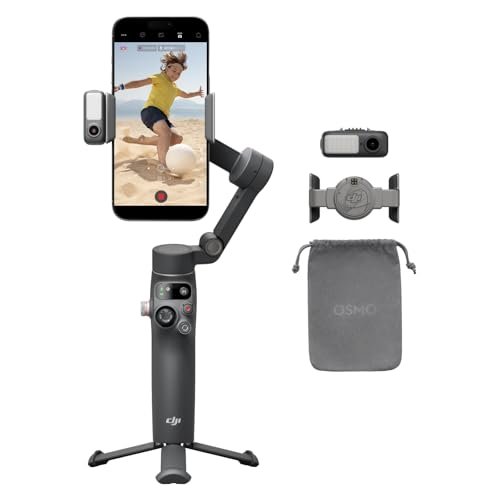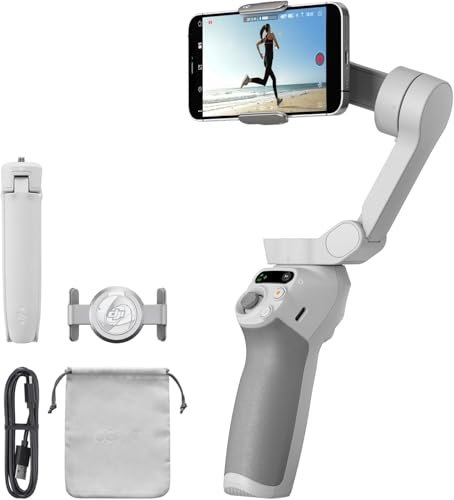Ever dreamed of capturing buttery-smooth, cinematic footage but thought professional-grade camera stabilizers were out of your budget? Well, you’re in luck! Finding the best bang for your buck gimbal stabilizer is totally achievable in today’s market. With advancements in technology, you no longer need to empty your wallet to get that steady, fluid look for your videos. Whether you’re an aspiring filmmaker, a dedicated vlogger, or just someone who wants to elevate their home videos, a good gimbal can be a total game-changer.
A gimbal stabilizer works by using motors and sensors to counteract unwanted camera movements, keeping your footage incredibly stable even when you’re walking, running, or shooting from challenging angles. It’s the secret sauce behind those professional-looking tracking shots and seamless transitions. But with so many options out there, how do you pick the one that gives you the most value for your money?
We’ve scoured the market to find three top contenders that truly represent the best bang for your buck gimbal stabilizer options available right now. These aren’t just cheap alternatives; they offer a fantastic balance of performance, features, and affordability. Let’s dive in and see which one might be the perfect fit for your next big project!
What to Look For in a Value-Packed Gimbal Stabilizer
Before we jump into the reviews, here’s a quick rundown of what makes a gimbal a “best bang for your buck” candidate:
- Payload Capacity: Can it handle your camera and lens setup?
- Stabilization Performance: How smooth is the footage it produces?
- Battery Life: Will it last through your shooting session?
- Ease of Use: Is it intuitive to set up and operate?
- Build Quality: Is it durable enough for regular use?
- Features: Does it offer useful modes like tracking, time-lapse, or object follow?
Now, let’s explore our top picks!
1. FeiyuTech SCORP-C [Official] Camera Stabilizer 3-Axis
![FeiyuTech SCORP-C [Official] Camera Stabilizer 3-Axis...](https://m.media-amazon.com/images/I/41cuk84JumL._SL500_.jpg)
The FeiyuTech SCORP-C is a robust and reliable 3-axis gimbal that truly delivers on its promise of stability for mirrorless and DSLR cameras. What makes this version particularly stand out is its upgraded payload capacity and its direct lineage from the well-regarded AK2000C, positioning it as a serious contender for users seeking professional stabilization without the premium price tag. It’s built for those who need a dependable workhorse to achieve smooth, cinematic footage with a wide range of camera setups.
Key Features:
– Compatible with mainstream mirrorless and DSLR camera & lens combos
– Upgraded max payload to 5.51 lbs, accommodating heavier setups
– Integrated handle grip design across the SCORP series for improved ergonomics
– Multi-Functional Knob Ring for precise control over camera focus and gimbal axis
– Extensive compatibility with various Sony, Canon, Nikon, and Fujifilm camera models
Pros:
– Excellent stabilization performance for crisp, shake-free video
– High payload capacity supports a wide range of professional cameras and lenses
– Integrated handle design enhances comfort and usability
– Intuitive knob for fine-tuning focus and axis control
– Good value for the features and performance offered
Cons:
– May be considered bulky for those seeking ultra-compact solutions
– Initial balancing can take some time, as with most professional gimbals
– Some users might prefer more physical customization options beyond the integrated handle
User Impressions:
Users frequently praise the FeiyuTech SCORP-C for its solid build quality and impressive ability to handle various camera systems. Many highlight the ease with which it transforms shaky handheld footage into smooth, professional-looking shots. While there’s a slight learning curve for balancing, owners generally feel it’s a small price to pay for the high-quality results it delivers, making it a favorite for content creators and indie filmmakers.
Call to Action: See it on Amazon here
2. FeiyuTech SCORP Mini 2 [White] All-in-One 3-Axis Mirrorless Gimbal
![FeiyuTech SCORP Mini 2 [White] All-in-One 3-Axis Mirorrless...](https://m.media-amazon.com/images/I/41S11kh+hFL._SL500_.jpg)
The FeiyuTech SCORP Mini 2 in its sleek white finish is a fantastic all-in-one solution that truly hits the sweet spot for creators on the go. Its compact size belies its powerful features, especially the game-changing built-in AI tracking sensor. This intelligent feature means you can focus on your shot while the gimbal automatically keeps your subject in frame, making it incredibly versatile for solo content creators or those needing an extra hand. It’s an ideal choice if you want advanced features packed into a more portable form factor.
Key Features:
– Built-in AI Tracking Sensor for automatic subject recognition and tracking
– Upgraded Quick-Release System for fast and easy camera mounting
– 1.3-inch OLED touchscreen for intuitive control and real-time data adjustment
– Multi-Functional Zoom Knob to control roll, pan, tilt angles, and camera focus
– Ergonomic Integrated Handle (T-shaped) designed for comfortable, extended shooting
Pros:
– AI tracking is a massive convenience for vlogging and dynamic shots
– Extremely portable and easy to carry with its quick-release system
– Intuitive touchscreen interface simplifies mode switching and settings
– Comfortable T-shaped handle reduces fatigue during long shoots
– Versatile controls for both gimbal movement and camera functions
Cons:
– Payload capacity is smaller compared to its larger SCORP-C siblings, limiting heavier cameras
– AI tracking might occasionally lose subjects in complex environments
– White finish may be more prone to showing dirt or wear over time
User Impressions:
Customers rave about the SCORP Mini 2’s AI tracking, calling it a “game-changer” for solo videographers. The compact size and quick-release system are also highly appreciated for their convenience. While it’s noted that it’s designed for lighter mirrorless setups, users are consistently impressed by the smooth stabilization and the intuitive control offered by the touchscreen and multi-functional knob. It’s often recommended for travel, vlogging, and everyday content creation.
Call to Action: See it on Amazon here
3. FeiyuTech SCORP-C Camera Stabilizer Handheld Gimbal for DSLR & Mirrorless Cameras

This iteration of the FeiyuTech SCORP-C really pushes the boundaries of a best bang for your buck gimbal stabilizer by focusing on innovative design and intelligent features that streamline the shooting process. Beyond its robust compatibility, its integrated hanging handle and folding aileron bracket offer unparalleled versatility for different shooting angles and self-standing convenience. If you’re looking for a gimbal that not only stabilizes but also enhances your creative workflow with smart memory functions and an impressive battery life, this is a top contender.
Key Features:
– Compatible with mainstream mirrorless and DSLR camera & lens combos (up to 5.5 lbs)
– Innovative Integrated Hanging Handle for upright or underslung shooting
– Tilted Handle Holding design for ergonomic comfort
– Integral folding aileron bracket allows it to be set down anywhere without a tripod
– Two-Point Memory, Intelligent Trajectory (AB points) for pre-set movements
– Three-Axis Lock & Magic Wheel for easy storage, balancing, and precise control of focus/zoom/axis
– Efficient Battery: 10-13 hour runtime with 18W fast charging (30 mins runtime in 5 mins charge)
Pros:
– Highly versatile shooting angles thanks to the integrated hanging handle
– Self-standing design is incredibly convenient for breaks or static shots
– Intelligent trajectory feature automates complex camera movements
– Excellent battery life with fast charging capabilities for prolonged shoots
– Axis locks and magic wheel simplify setup, transport, and operation
– Broad camera compatibility with specific models listed for clarity
Cons:
– Learning curve for mastering all the advanced features like AB points
– Despite the innovative design, it’s still a substantial piece of gear for travel
– Some users might find the range of buttons and functions overwhelming initially
User Impressions:
Users frequently highlight the ingenious design of the SCORP-C, particularly the integrated stand and versatile handle, which they find incredibly practical. The long battery life and quick charging are also major pluses, ensuring they can shoot for extended periods without interruption. While the array of features can take some getting used to, the consensus is that this gimbal offers professional-grade stabilization and advanced control that far exceeds its price point, making it a fantastic investment for serious videographers.
Call to Action: See it on Amazon here
Conclusion
Choosing the best bang for your buck gimbal stabilizer doesn’t mean compromising on quality or features. As you can see from our top FeiyuTech picks, there are fantastic options available that cater to different needs and camera setups while still offering incredible value.
The FeiyuTech SCORP-C (Product 1 & 3) is a powerhouse for those with heavier mirrorless and DSLR rigs, offering robust stability and professional features like intelligent trajectory and excellent battery life. If portability and smart, automated tracking are your priority, the FeiyuTech SCORP Mini 2 stands out with its built-in AI tracking and compact design.
Ultimately, the right gimbal for you depends on your specific camera, shooting style, and what features you value most. Whichever you choose, investing in one of these top-value gimbals will undoubtedly elevate your video production, giving you that smooth, professional look you’ve always wanted without breaking the bank. Happy shooting!
Frequently Asked Questions (FAQ)
Q1: What exactly is a gimbal stabilizer and why do I need one?
A1: A gimbal stabilizer is a device that uses motors and intelligent sensors to keep your camera perfectly level and smooth, even when you’re moving. You need one to eliminate shaky footage, achieving that professional, cinematic look common in movies and high-quality vlogs. It’s essential for dynamic shots like walking, running, or panning smoothly.
Q2: What’s the main difference between a 2-axis and a 3-axis gimbal?
A2: A 2-axis gimbal stabilizes on two axes (usually tilt and roll), while a 3-axis gimbal stabilizes on all three axes (tilt, roll, and pan). A 3-axis gimbal offers superior stability and flexibility, eliminating shake from all directions, which is crucial for truly smooth and professional video. All the gimbals reviewed here are 3-axis.
Q3: How do I choose the right gimbal stabilizer for my camera?
A3: The most critical factor is payload capacity. Ensure the gimbal can comfortably support the combined weight of your camera and your heaviest lens. Also, consider compatibility (check the manufacturer’s list), battery life, ease of balancing, and specific features like AI tracking or integrated handles that suit your shooting style.
Q4: Is it difficult to balance a camera on a gimbal?
A4: Balancing a gimbal can seem tricky at first, but it gets easier with practice. It involves adjusting the camera’s position on the gimbal arms until it remains level and still without motor assistance. Most gimbals come with clear instructions, and there are many online tutorials available to guide you through the process step-by-step. Proper balancing ensures optimal performance and battery life.
Q5: What is “payload capacity” and why is it important?
A5: Payload capacity refers to the maximum weight a gimbal can effectively support and stabilize. It’s crucial because if your camera and lens combination exceeds the gimbal’s payload, the motors will struggle, leading to poor stabilization, increased motor noise, and potential damage to the gimbal over time. Always check your camera setup’s weight and compare it to the gimbal’s specifications.
Q6: Can I use these gimbals with my smartphone?
A6: The gimbals reviewed in this article (FeiyuTech SCORP-C and SCORP Mini 2) are primarily designed for mirrorless and DSLR cameras. While some gimbals are made for smartphones, these models are built to handle the larger size and weight of dedicated cameras and typically require specific camera control cables.
Q7: How important is battery life for a gimbal stabilizer?
A7: Battery life is very important, especially if you plan on long shooting sessions or don’t have access to charging points on location. A longer battery life means fewer interruptions and more reliable performance throughout your day. Many modern gimbals also feature fast charging, which is a great bonus for quick top-ups.


